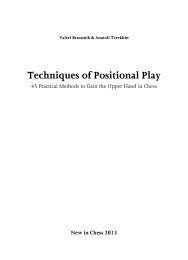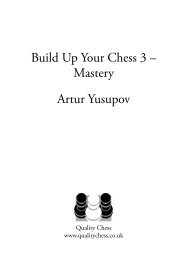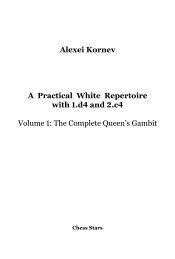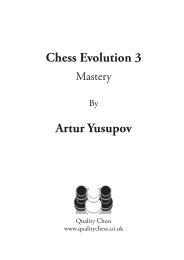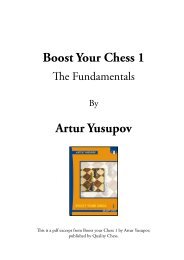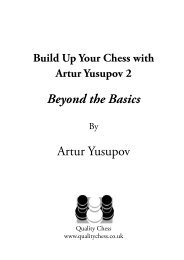Boost Your Chess 2 Artur Yusupov - Quality Chess
Boost Your Chess 2 Artur Yusupov - Quality Chess
Boost Your Chess 2 Artur Yusupov - Quality Chess
You also want an ePaper? Increase the reach of your titles
YUMPU automatically turns print PDFs into web optimized ePapers that Google loves.
chapter 1<br />
Contents<br />
ü Significance of the attack<br />
on the king<br />
ü Preconditions for a<br />
successful attack on the king<br />
ü Removing a defender<br />
ü Exploiting the open<br />
king position<br />
ü Sacrifices<br />
ü Forced moves<br />
Attacking the king<br />
The attack on the king has the highest priority of all<br />
in chess. For a successful attack on the king, you can<br />
sacrifice almost the whole army. But attacks do not<br />
always work. Before Steinitz, many players believed<br />
that it was only the player’s tactical abilities that had<br />
any part to play. Steinitz established that a successful<br />
attack can only be mounted if based on positional<br />
advantages – such as the initiative, better development,<br />
control over important central squares, etc.<br />
But whoever has the chance to attack must do so<br />
in the most energetic manner!<br />
In the following examples, look for the most<br />
active continuation! Bring your pieces closer to<br />
the opposing king, open up the position for your<br />
rooks and bishops, break up your opponent’s<br />
castled position, create specific threats!<br />
But you must also remain realistic: sometimes our<br />
attack on the king is ‘only enough to win material’!<br />
W.Steinitz – C.von Bardeleben<br />
Hastings 1895<br />
Diagram 1-1<br />
r<br />
1222222223<br />
Çt+ Wl+ T5<br />
ÆOoO +oOo5<br />
Å +m+v+ +5<br />
Ä+ +m+ + 5<br />
à VbP + +5<br />
Â+ N +n+ 5<br />
ÁpP + PpP5<br />
ÀR Bq+rK 5<br />
7ÈÉÊËÌÍÎÏ9<br />
8<br />
1.e4 e5 2.¤f3 ¤c6 3.¥c4 ¥c5 4.c3 ¤f6 5.d4 exd4<br />
6.cxd4 ¥b4† 7.¤c3!<br />
An old gambit line. 7.¥d2 is the safer way.<br />
7...d5!<br />
A better option is 7...¤xe4 8.0–0 ¥xc3, as in the<br />
game Steinitz – Schlechter in the same tournament.<br />
8.exd5 ¤xd5 9.0–0 ¥e6<br />
Diagram 1-1<br />
It is risky for Black to take the pawn as White’s lead<br />
in development would be too great. After 9...¤xc3<br />
10.bxc3 ¥xc3 comes 11.¥xf7† ¢f8 12.£b3! ¥xa1<br />
13.¥a3† ¤e7 14.¦e1+–; while if 9...¥xc3 10.bxc3<br />
¤xc3, then 11.£b3 gives White a strong attack.<br />
10.¥g5!<br />
White brings his bishop into the game with tempo,<br />
thus increasing his lead in development.<br />
10...¥e7!<br />
For his part, Black loses a tempo. However, it is very<br />
difficult to correctly evaluate the attack which ensues.<br />
8



